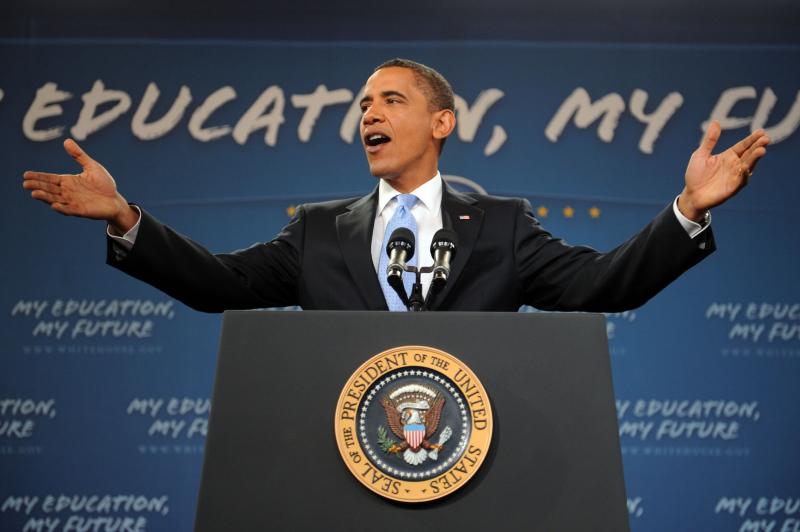The Bureau of Labor Statistics releases a study of U.S. occupations every two years, showing the number of jobs in each occupation, its educational requirements, and how much it pays. Though the specifics change, every two years the study shows that a large majority of jobs now and in the future require no education beyond high school. And every two years the carefully compiled BLS data is ignored, leaving the field clear for everybody from the editorial pages of The Wall Street Journal to President Obama to proclaim that “education is the answer” to economic inequality, poverty, and low wages.
“Graduating college is highly overrated” is about as half-true, and therefore false, as “education is the answer.” But each claim has some evidence to support it.
Not much education is required for most American jobs (now and in the future) and more education leads to higher pay and steadier employment. It is only when you put the two half-truths together that you can see the whole picture.
According to the BLS, in 2012 only 22 percent of all jobs required a bachelor’s degree or more, and of the more than 50 million job openings the BLS projects by 2022, only 22 percent will require a bachelor’s or more. (In fact, if all you have is a bachelor’s degree, there are only 17 percent of jobs now and 17 percent of job openings projected by 2022 that require that degree and no more.)
Problem is that about 32 percent of the population over the age of 25 has a bachelor’s, and among young people ages 25 to 34, it is a bit higher at 34 percent. In other words, there are only two jobs for every three persons who have a bachelor’s degree, and the number of people getting bachelor’s degrees is growing faster than the number of jobs that require that degree—or anything close to it.
Indeed, 26 percent of jobs in 2012 did not even require a high school diploma, and another 40 percent required only a high school diploma. And the BLS projects that it will get worse by 2022, when nearly a third of all job openings will require “less than high school.”
There is a more ambiguous category of jobs that require some “postsecondary education,” whether an associate’s degree or some kind of specialized training certificate or simply “some college.” But they are required for only about 11 percent of jobs now, and are projected to provide about 12 percent of job openings going forward.
The table below summarizes how overeducated our population is for the jobs we actually have.
|
Level of education |
||
| Less than high school |
12 |
26 |
| High school diploma |
30 |
40 |
| Some college, A.A., or postsecondary |
26 |
11 |
| Bachelor’s or higher |
32 |
22 |
We have an oversupply of jobs that require high school or less (66 percent) compared to the 42 percent of people whose education fits those jobs. And conversely, we have an oversupply of people with some postsecondary education (58 percent) for the 33 percent of jobs that require something like that level of education.
Just looking at what jobs are now and will be available in the U.S. economy, graduating college seems highly overrated—and it might even be that “going to college is for suckers.” If all you need for most jobs is a high school education, why bother with college? That’s simple: wages.
A recent Pew Research Center study, The Rising Cost of NOT Going to College, looks at how income correlates with earnings. As previous studies have found, high school graduates make $7,000 more a year than those who do not graduate. Those with “some college” make an additional $2,000, and those who get bachelor’s degrees make $13,000 more on top of that.
The gradient could not be clearer: those with bachelor’s degrees have average incomes twice that of those without high school diplomas ($45,000 vs. $23,000). What’s more, unemployment rates, poverty rates, and other things follow a similar gradient: the more education, the lower the unemployment rate, the lower the poverty rate, and the more likely you are to have full-time employment and employer-paid benefits.
Conversely, though there are and will be plenty of jobs for people who do not graduate from high school and for those whose education ends with a high school diploma, these jobs generally pay miserable wages—almost uniformly less than $30,000 a year, and most much less.
So, “education is the answer” has some evidence to support it, too. But both statements are half-truths—not much education is required for most American jobs (now and in the future) and more education leads to higher pay and steadier employment. It is only when you put the two half-truths together that you can see the whole picture.
If you are an individual 18 year old, your only chance for a decent income is to go to college or to get some other form of postsecondary education. Statistically, it will give you a 2 to 1 shot at a decent standard of living vs. a thousand to one for high school graduates and a million to one for those who never graduate from high school. But if all 18-year-olds—or even most of them—play these odds by going to college, it will do nothing to remedy economic inequality, low wages, and poverty. In fact, it would probably make all these things worse.
The increasing imbalance of supply and demand—more college graduates than jobs that require them—puts downward pressure on the wages of jobs that require higher education and ensures that more college graduates will be forced to take jobs that do not require college.
Pew found that more than a third of recent college graduates it surveyed were working in jobs that do not require any college. Likewise, as more college graduates take jobs that require only high school, more high school graduates are forced to take jobs that do not require a high school diploma, and those who did not graduate from high school have great difficulty finding and keeping any job. More and more education is required to attain a decent standard of living, but as more and more people gain higher levels of education, they further flood those higher-paying job markets, leading to lower average wages and living standards for everybody.
It’s a perfect formula for cheapening all labor.
Jack Metzgar is a core member of the Chicago Center for Working-Class Studies. He writes for Working-Class Perspectives, where this originally appeared.





0 Comments